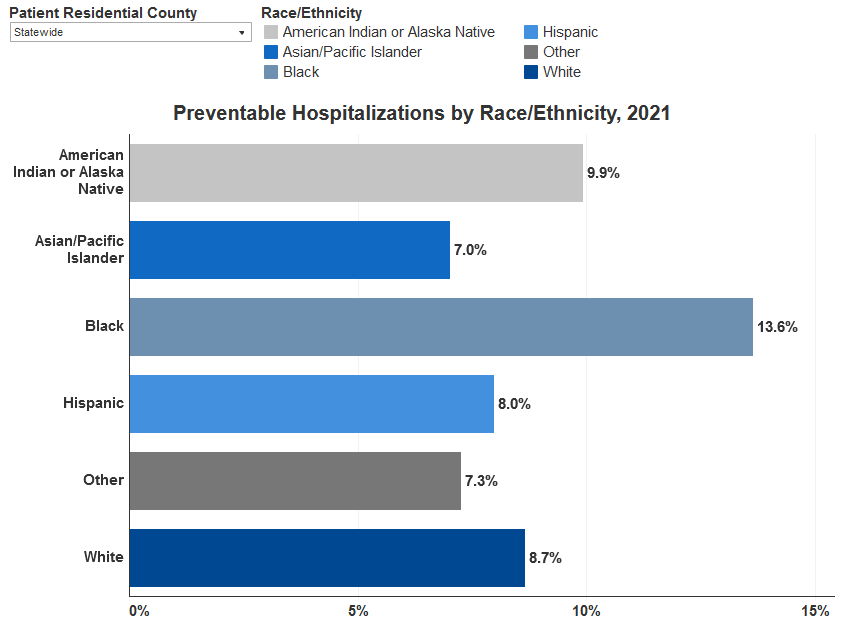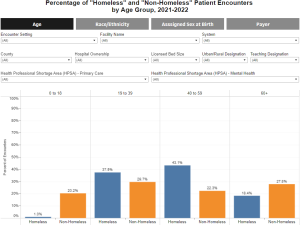Social and Community Impact with Data
HCAI collects and manages data from across California’s health care system to promote transparency and empower communities with data and evidence. HCAI’s Social and Community Impact page highlights core data programs that provide transparency into the direct social and community impacts of California’s hospitals with a focus on social drivers of health, or SDoH.
According to Healthy People 2030, social drivers of health are the conditions in the environments where people are born, live, learn, work, play, worship, and age that affect a wide range of health, functioning, and quality-of-life outcomes and risks. Social drivers of health are typically grouped in a few general categories including: economic stability, education access and quality, healthcare access and quality, social and community context, and neighborhood and built environment. Taking these broad categories HCAI has identified six priority social drivers for which HCAI data can be reported: preferred language spoken, the actual payer or entity that will pay the greatest share of medical bills, employment rate, rate of park access, homeownership rate, and homes with basic kitchen facilities.
Understanding and addressing these drivers are essential for developing effective interventions, reducing health disparities, and promoting overall community health and resilience. As additional data becomes available, this webpage will reflect the healthcare system’s evolving efforts to address these social drivers within California’s communities.
Social Drivers of Health and Preventable Hospitalizations
To better understand the relationship between the healthcare delivery system and the interplay of social drivers of health and race/ethnicity, HCAI has developed the following analysis for preventable hospitalizations and patient race/ethnicity in combination with key social drivers.

Featured Visualizations
HCAI produces various visualizations based on data that can be stratified based on race, ethnicity, payer, sex, and more. Included below are examples of visualizations that demonstrate meaningful data of California’s diverse communities through an equity lens. See more of HCAI’s visualizations on the featured visualizations page.
Programs
Hospital Equity Reporting
Program overview: Collection of hospital equity reports and the hospitals’ plan to prioritize and address disparities for vulnerable populations. New program being developed for hospital quality and equity reporting. First set of reports will be due in 2025.
Impact: Equity reporting will require hospitals to highlight their plan to prioritize and address disparities for vulnerable populations identified in data, and as specified by the Advisory Committee. The Committee recommended a number of measures considering hospital equity measures that directly correlate with the Healthy Places Index in an effort to incorporate social drivers of health in the disparity analysis prepared by hospitals. By identifying inequities and creating a plan to address those, hospitals will develop approaches to reduce inequities within their patient populations. Review the Committee’s recommendations here. HCAI aims to further these efforts through publishing hospital equity reports and ensuring accountability of hospitals in accurately completing and submitting these reports on an annual basis.
Hospital Equity Data Toolkit
HCAI has developed a Hospital Equity Data Toolkit, a collection of resources for hospitals that outline best practices to enhance demographic healthcare quality data collection, analysis, reporting and equity planning. This collection of resources was developed in collaboration with the Hospital Equity Measures Advisory Committee. The page and resources are an evolving curation, intending to be informative and updated regularly.
Hospital Supplier Diversity
Program overview: Collection of hospital supplier diversity reports explaining the hospital’s supplier diversity statement and expressing its goals regarding procurement efforts with hospitals. Reports are collected annually on July 1.
Impact: Hospitals are uniquely positioned to build relationships within the communities they serve through the development, inclusion, and utilization of certified minority, women, lesbian, gay, bisexual, transgender (LGBT), and disabled veteran business enterprises whenever possible. HCAI aims to disseminate transparent data that highlights the state’s hospital procurement with diverse suppliers as it directly impacts California’s diverse business owners and communities served.
Hospital Supplier Diversity Public Reports
HCAI has been collecting supplier diversity reports since July 2020. Starting with 2021 reporting year, HCAI has developed a user friendly report visualization tool, which allows users to easily navigate between reported data from hospital to hospital in a single report year. The links below are for each of the reporting years.
HCAI has also developed a Pivot Table (linked below) which is an interactive view of California’s Hospitals procurement data over the last three reporting periods (2021-2023). The data is illustrated through charts and graphs can be broken down by specific categories and filters, allowing for a more comprehensive view of California’s Hospitals.
All underlying data for all reporting years is available on the Open Data Portal.
- 2020 Supplier Diversity Reports*
- 2021 Supplier Diversity Reports
- 2022 Supplier Diversity Reports
- 2023 Supplier Diversity Reports
- 2023 Supplier Diversity – Statewide Report
- 2021 – 2023 Hospital Supplier Diversity Pivot Table
- Underlying data available on the Open Data Portal
*Note: The 2020 reports were submitted prior to regulations being effective, and is not standardized and comparable with reports from 2021 and ongoing.
Hospital Community Benefits
Program overview: Collection of hospital reported community benefits and plans for addressing priority health needs in collaboration with the community.
Impact: Private not-for-profit hospitals meet certain needs of their communities through the provision of essential health care and other services. Nonprofit hospitals assume a social obligation to provide community benefits in the public interest. HCAI aims to collect and disseminate data that indicates private not-for-profit hospitals’ ability to meet the needs of their communities through a lens of data transparency and accountability.
Hospital Fair Billing Program
Program overview: The Hospital Fair Billing Program enforces the Hospital Fair Pricing Act. The program reviews and approves hospital billing policies including discount payment, charity care, and debt collection policies as well as investigates patient complaints and assess administrative penalties against hospitals for violations of the Hospital Fair Pricing Act.
Impact: Nationally, medical expenses are the largest contributor to increasing the number of individuals in poverty. The Hospital Fair Billing Program provides relevant information to patients in communities who may need assistance. Establishing transparent billing and debt collection procedures prevents unfair billing practices and empowers patients to make informed health care decisions. HCAI aims to provide transparency through the publication of these policies and accountability through the imposition of administrative penalties for violation of the Hospital Fair Pricing Act. HCAI also directly supports consumers who may have been improperly billed, helping to reduce the number of patients experiencing financial hardships due to medical debt.
Get Involved
HCAI programs often have advisory committees and public meetings to discuss program goals, data reporting, and regulations. These meetings are open to the general public where members of the community can provide feedback. Get involved and have your voice heard! To learn more about public meetings, visit HCAI’s public meetings page below and subscribe here to get notices of new meetings.




